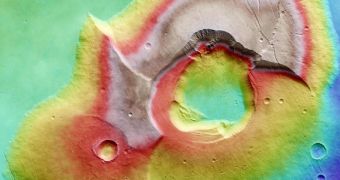Eons ago, the Tharsis Tholus volcano on the surface of the Red Planet may have played an important role in shaping the planetary crust at and around its location. Right now, the mountain looks as if it was pummeled to the ground with a large bat.
Over countless years, erosion and space impacts brought the mountain to only a shadow of its former self. Its eastern and western flanks have both collapsed, reducing the height of the once-proud volcano. Even now, after suffering so much damage, it still towers 8 kilometers (5 miles) above its surroundings.
Its base covers an area about 155 by 125 kilometers (96 by 77.6 miles). ESA's Mars Express imaged the entire landscape feature using the HRSC high-resolution stereo camera instrument. The data allowed experts to determine why such a large caldera formed at this location.
It is know believed that the last eruption was so intense that the entire magma chamber was emptied. The roof of the chamber had no way of supporting its own weight, and therefore collapsed to create this immense caldera.

 14 DAY TRIAL //
14 DAY TRIAL //